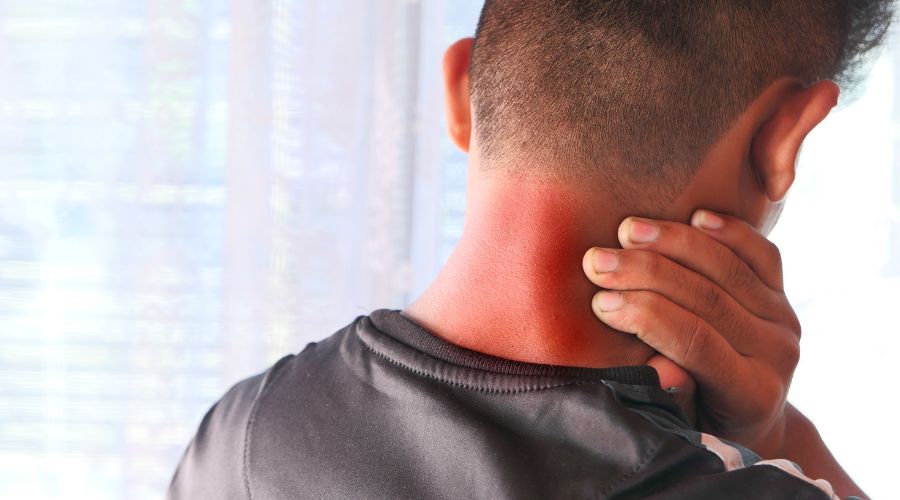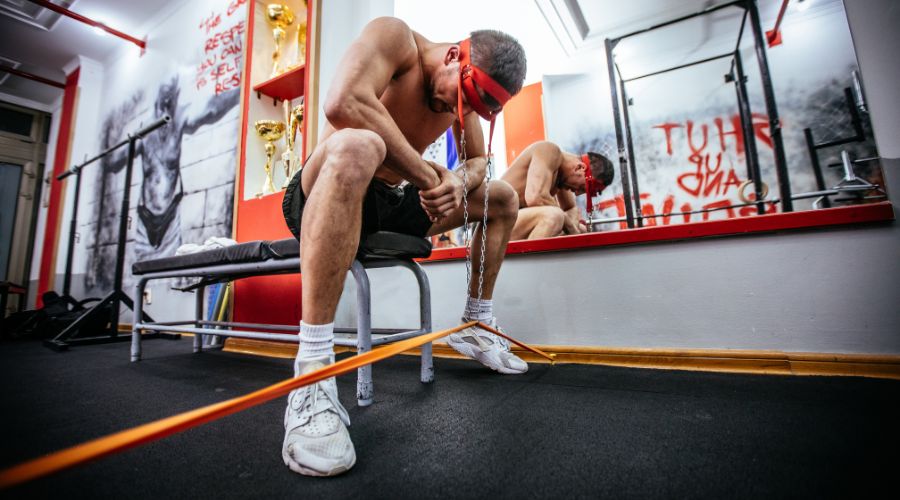BJJ is in the business of rearranging limbs, and chokes stand at the top of the submission hierarchy. This places the precious neck muscles and cervical vertebrae under frequent pressure and danger, making neck pain inevitable. But how can we better deal with it?
Building a strong and mobile neck can minimize the chance of serious injuries. This is done by isometric and resistance exercises, which strengthen the muscles placed under pressure in many positions and choke holds commonly used in BJJ.
There’s more to neck pain in BJJ than building strength, though, and it’s valuable to know what types of injuries can occur, how to best prevent them, and how to deal with the pain when it inevitably comes.
What Causes Neck Pain After Jiu-Jitsu
The neck is one of the most commonly injured body parts in jiu-jitsu. The sport’s nature is such that many grips and attacks target the area, and the neck must withstand serious force.
Be it to resist a grip, to post on the head to prevent being swept, to endure a nasty neck crank like the can opener, or some of the many strangulations found in jiu-jitsu, the neck does a lot of heavy work during grappling.
The danger is present at every practice and even more so during competition, meaning the chance for an injury or at least pain is high.
The neck comprises of 26 muscles keeping the head stable and moving. The factors mentioned above can push them outside their normal range of motion, creating a high risk for soft tissue or spinal injury.
There are a few possible causes of neck pain, some that should not cause concern and others that can be very dangerous.
Minor Injuries

Usually, neck pain is caused by muscle damage, which is the least dangerous option. The spine is a crucial part of the human body, and the muscles will do everything to protect it, including tightening too much in certain positions to prevent spinal damage. This tightening or spasms cause pain.
Having a stiff neck is inevitable, especially early in your journey or if you haven’t trained in a while, because the muscles will get overworked from the constant pulling and tugging. This is nothing to worry about and will pass after a few days.
Some neck sprains and strains are also likely to happen during training. A neck sprain affects the muscles and tendons and is usually caused by overstretching the neck. Sprains are caused by ligament damage, commonly caused by neck rotation beyond its possible range of motion.
The two symptoms are similar: pain and stiffness, pain in the upper back and shoulders, decreased range of motion, headaches, and more. If the pain and discomfort recede daily, they shouldn’t be a cause for concern.
Serious Neck Injuries
The neck and spine are too important to neglect, and more serious injuries and conditions require an immediate visit to a doctor or physiotherapist.
The injury may have affected the cervical disks or some of the nerves between them, which is cause for serious concern. If you have any of the following symptoms, visit the doctor as soon as possible, and don’t try to tough it out.
- Chronic pain- if the pain does not decrease as usual or is consistent weeks after the incident, the problem is likely serious
- Dizziness, nausea, and bad headaches
- Pins and needles in the hands and legs may indicate nerve problems
- Problems with eyesight
And even if the symptoms are not severe and can be considered a minor injury, seeing a professional is never a bad idea. This is advice few BJJ guys adhere to, myself included, but it’s worth saying nonetheless.
How To Prevent Neck Pain and Injuries

As with so many other things, prevention is usually the best route. You cannot prevent all injuries and accidents will happen; it’s just part of the territory. But by following some simple steps and routines, you can drastically reduce the chance and severity of neck injuries from BJJ.
Build A Strong And Mobile Neck
Developing neck strength and mobility is the most significant factor in neck injury prevention. Your neck muscles will get stronger from BJJ training because of all the pressure and tension, but relying on this alone is insufficient.
Having a dedicated neck strength routine is the way to go, and it will significantly benefit your BJJ game and reduce the chance of injury.
Proper neck training includes isometric strength exercises in all directions and flexion, lateral flexion, extension, and rotation with and without resistance to build a robust neck ready for guillotines, bridges, and even neck cranks.
These things can be trained without equipment, but using bands and weight plates dramatically helps, especially once you build decent strength and want to progress. And if you need a single neck trainer to take care of all your neck training, the Iron Neck is the perfect solution.
The wrestler’s bridge is a favorite exercise of wrestlers because it strengthens the neck immensely in positions commonly used in the sport.
But it’s also a very dangerous move because it compresses the vertebrae and can lead to some nasty injuries, and I wouldn’t recommend you do it for BJJ. Wrestlers need to bridge on the head during grappling, but BJJ guys rarely need to do so, and the risk is not worth it when there are more than enough safer methods to build a strong neck.
Warm Up And Cool Down
Warming up your neck properly, even before light drills, is important to reduce stiffness and minimize the chance of injuries, just like it is for all body parts. Use active, full-range-of-motion neck exercises for the best results.
You probably know this already, but you may not know which cool-down exercises can help prevent neck pain after training.
Some passive stretches and slow mobilization exercises immediately after training are a great way to reduce the strain on the neck and possibly reduce muscle soreness and pain. Here is a simple sequence you can do during the cool-down of the session.
Tap Early
This one is straightforward and rings true for all submissions and body parts, not simply the neck. You are sparing your neck pain and tension by tapping out when you feel there is no escape from the choke and not fighting it. The ego is your enemy on the mats most of the time.
But sometimes, you need to know how much you can withstand and when you can’t escape, especially if you are a competitor. So, pushing the limits has its place in training, but it can be done in a more controlled way through specific drills.
We’ve all fought submissions way longer than we should have and paid the price the next day, and we likely will do it many more times, but tapping early is still one of the best pieces of advice one could receive.
Dealing With Neck Pain From BJJ

You shouldn’t be training if you have a serious neck injury or severe pain. But you can train around it with a few minor adjustments if you have light to moderate pain.
Depending on the level of pain, you can adjust your training to not aggravate the neck even further. This can mean not starting standing or even kneeling to avoid partners pulling at your neck. Or you can drill and avoid free rolling while the injury heals.
This can also be a good time to drill movements not involving the neck, like leg locks. Or if the pain is severe (and the doctor told you it’s nothing serious) but you still want to train, you can also go for a strength and conditioning routine where there is no tension on the neck whatsoever.
Summary
Neck pain from BJJ is something everyone experiences. The pulling, pushing, and choke hold put the neck’s soft tissues and disks under pressure and in danger of injury. While stiffness and soreness are inevitable occasionally, more serious injuries to the spine and nerves are no joke.
By warming up and cooling down, and most importantly, building strength and mobility in the neck, you can reduce the chance of injuries and decrease the frequency and severity of pain.
